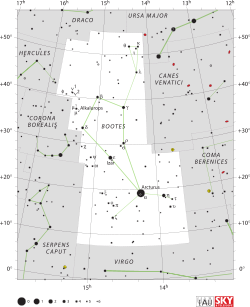Mu Boötis,Latinizedfromμ Boötis,consists of a pair ofdouble starsin the northernconstellationofBoötes,120light-yearsfrom theSun.
Mu Boötis had the traditional nameAlkalurops/ælkəˈljʊərɒps/,although theInternational Astronomical Unionnow regards that name as only applying to μ1Boötis.[11]
System
editThe primary pair, component A, is designated μ1Boötis and the two components anangular separationof 0.08″.[citation needed]
The secondary, consisting of components BC, is designated μ2Boötis and they have a separation of 2.2″. The two double star systems are separated by 107″, with matching parallaxes andproper motions,suggesting they form a system. However, components BC have a different chemical composition compared to the A pair, indicating this may instead be a close encounter between two binary systems.[6]
Nomenclature
editμ Boötis(LatinisedtoMu Boötis) is the star'sBayer designation.It also bears theFlamsteed designation51 Boötis.
The system's traditional nameAlkaluropsis from theGreekκαλαύροψkalaurops"a herdsman's crook or staff", with theArabicprefix attached.[12]It has also been known asInkalunis(from theAlfonsine tables),Clava(Latin'the club') andVenabulum(Latin 'a hunting spear').[13]In 2016, theInternational Astronomical Unionorganized aWorking Group on Star Names(WGSN)[14]to catalogue and standardize proper names for stars. The WGSN approved the nameAlkaluropsforμ¹ Boötison 21 August 2016 and it is now so entered in the IAU Catalog of Star Names.[11]
It is known as thất công lục, Qī Gōng liù (the Sixth Star of the Seven Excellencies) in Chinese.[15]
Properties
editμ1Boötis is a yellow-whiteF-typesubgiantwith anapparent magnitudeof +4.31.
Separated from its brighter companion by 108arcsecondsin the sky is thebinary starμ2Boötis, which has a combined spectral type of G1V and a combined brightness of +6.51magnitudes.The components of μ2Boötis have apparent magnitudes of +7.2 and +7.8 and are separated by 2.2arcseconds.[citation needed]They complete one orbit about their common centre of mass every 260 years.
References
edit- ^abcdeVallenari, A.; et al. (Gaia collaboration) (2023)."GaiaData Release 3. Summary of the content and survey properties ".Astronomy and Astrophysics.674:A1.arXiv:2208.00211.Bibcode:2023A&A...674A...1G.doi:10.1051/0004-6361/202243940.S2CID244398875. Gaia DR3 record for this sourceatVizieR.
- ^abMalagnini, M. L.; Morossi, C. (November 1990), "Accurate absolute luminosities, effective temperatures, radii, masses and surface gravities for a selected sample of field stars",Astronomy and Astrophysics Supplement Series,85(3): 1015–1019,Bibcode:1990A&AS...85.1015M.
- ^abcdefghVallenari, A.; et al. (Gaia collaboration) (2023)."GaiaData Release 3. Summary of the content and survey properties ".Astronomy and Astrophysics.674:A1.arXiv:2208.00211.Bibcode:2023A&A...674A...1G.doi:10.1051/0004-6361/202243940.S2CID244398875. Gaia DR3 record for this sourceatVizieR.
- ^abTokovinin, Andrei (2018-03-01), "The Updated Multiple Star Catalog",The Astrophysical Journal Supplement Series,235(1): 6,arXiv:1712.04750,Bibcode:2018ApJS..235....6T,doi:10.3847/1538-4365/aaa1a5,ISSN0067-0049,S2CID119047709.
- ^abcdefghVallenari, A.; et al. (Gaia collaboration) (2023)."GaiaData Release 3. Summary of the content and survey properties ".Astronomy and Astrophysics.674:A1.arXiv:2208.00211.Bibcode:2023A&A...674A...1G.doi:10.1051/0004-6361/202243940.S2CID244398875. Gaia DR3 record for this sourceatVizieR.
- ^abcdefghijklmnopqrstuKiyaeva, O. V.; et al. (November 2014), "The multiple system ADS 9626: A quadruple star or an encounter of two binaries?",Astronomy Reports,58(11): 835–848,Bibcode:2014ARep...58..835K,doi:10.1134/S106377291411002X,S2CID122667185.
- ^abcdJohnson, H. L.; et al. (1966), "UBVRIJKL photometry of the bright stars",Communications of the Lunar and Planetary Laboratory,4(99): 99,Bibcode:1966CoLPL...4...99J.
- ^Gontcharov, G. A. (November 2006), "Pulkovo Compilation of Radial Velocities for 35495 Hipparcos stars in a common system",Astronomy Letters,32(11): 759–771,arXiv:1606.08053,Bibcode:2006AstL...32..759G,doi:10.1134/S1063773706110065,S2CID119231169.
- ^Anderson, E.; Francis, Ch. (2012), "XHIP: An extended hipparcos compilation",Astronomy Letters,38(5): 331,arXiv:1108.4971,Bibcode:2012AstL...38..331A,doi:10.1134/S1063773712050015,S2CID119257644.
- ^Zorec, J.; Royer, F. (January 2012), "Rotational velocities of A-type stars. IV. Evolution of rotational velocities",Astronomy & Astrophysics,537:A120,arXiv:1201.2052,Bibcode:2012A&A...537A.120Z,doi:10.1051/0004-6361/201117691,S2CID55586789.
- ^abMamajek, Eric; et al. (June 30, 2017),IAU Catalog of Star Names,IAU Division C Working Group on Star Names,retrieved28 July2016.
- ^Allen, Richard H.(1963),Star Names: Their Lore and Meaning(Reprint ed.), New York: Dover Publications Inc, p.97,ISBN0-486-21079-0,retrieved2016-09-15
- ^Allen, Richard H.(1963),Star Names: Their Lore and Meaning(Reprint ed.), New York: Dover Publications Inc, p.105,ISBN0-486-21079-0,retrieved2016-09-15.
- ^IAU Working Group on Star Names (WGSN),International Astronomical Union,retrieved22 May2016.
- ^(in Chinese)AEEA (Activities of Exhibition and Education in Astronomy) thiên văn giáo dục tư tấn võng 2006 niên 6 nguyệt 26 nhậtArchived2011-05-22 at theWayback Machine
